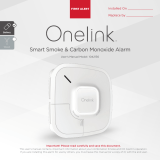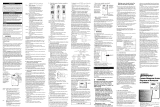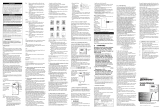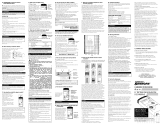
69-1513EF-01
OWNER’S GUIDE
RESIDENTIAL USE ONLY
C8600A
CO Alarm

69-1513EF—01 2
Features
• Patented carbon monoxide (CO) alarm
technology detects CO similar to human
body’s response.
• Detects and warns against conditions
that can lead to acute and chronic effects
of CO poisoning.
• Detects toxic CO gas resulting from
incomplete combustion such as emitted
from appliances, furnaces, fireplaces and
auto exhaust.
• Detects CO gas from any source of
combustion.
• Use in combination with other
combustible gas, fire or smoke alarms.
• Detects levels of carbon monoxide at 70
ppm and above.
• For residential use only.
What You Should Know About
Carbon Monoxide (CO)
— Colorless, odorless, and tasteless gas.
— Cumulative poison.
— Even low levels can cause brain and other
vital organ damage in unborn infants with no
effect on the mother.
— Symptons of carbon monoxide poisoning
should be discussed with all members of the
household:
a. Mild Exposure—Slight headache,
nausea, vomiting, fatigue (often
described as flu-like symptoms).
b. Medium Exposure—Severe throbbing
headache, drowsiness, confusion,
fast heart rate.
c. Extreme Exposure—Unconscious-
ness, convulsions, cardio-respiratory
failure, death.

3 69-1513EF—01
d. Disoriented—Victims are often aware
they are not well, but are so disori-
ented, they are unable to save them-
selves by either exiting the home or
calling for assistance. (Young children
and household pets may be the first
affected.)
What CO Alarm Can/Cannot Do
• This alarm indicates the presence of carbon
monoxide gas at the sensor. Carbon
monoxide gas may be present in other
areas.
• This alarm is not a substitute for other
combustible gas, fire or smoke alarms.
• This CO alarm may not sense CO on a
different level or floor of a residence or
building; for example, a second floor alarm
may not sense a CO leak on the first floor or
in the basement:
— Place alarms on every level of a resi-
dence as shown in Fig. 1.
• This CO alarm may not be heard behind
closed or partly closed doors such as in
bedrooms:
• Place alarms in each bedroom and in the
hallway if bedroom doors are closed or partly
open at night; an alarm outside a door may
not awaken occupants.
WARNING
CO Alarm does not measure in
compliance with Occupational Safety
and Health Association (OSHA)
commercial or industrial standards.
CO Alarm is for use only in indoor
family living units.
This alarm has not been investigated for
CO detection below 70 ppm.

69-1513EF—01 4
WARNING
Individuals with Medical Problems
Alert.
Inability of this device to detect low
carbon monoxide levels below 70
ppm.
Use alternate detection and warning
device that provides audible and visual
signals for CO levels below 30 ppm.
• CO alarms are not a substitute for
insurance. Installing CO alarms may qualify
you for lower insurance rates.
— This CO alarm is not designed for use in
marine or recreational vehicles.

5 69-1513EF—01
Developing Your CO Safety Plan
WARNING
Actuation of your CO Alarm indicates
the presence of carbon monoxide
that can KILL YOU.
If alarm sounds:
1) Operate reset/silence button.
2) Call your emergency services
telephone number (-----------), fire
department or 911.
3) Immediately move to fresh air
outdoors or near an open door/window.
Take a head count to check that all
persons are accounted for. Do not re-
enter your home or move away from the
open door/window until the emergency
services responders have arrived, the
home is aired out, and your alarm
remains in normal condition.
4) After following steps 1-3, if your
alarm reactivates within a 24-hour
period, repeat steps 1-3 and call a
qualified appliance technician (-----------)
to investigate sources of CO from fuel-
burning equipment and appliances, and
inspect this equipment for correct
operation. If problems are identified
during this inspection, have the
equipment serviced immediately. Note
any combustion equipment that the
technician did not inspect, and consult
the manufacturer’s instructions, or
contact the manufacturers directly for
more information about CO safety and
this equipment. Make sure motor
vehicles are not, and have not been
operating in an attached garage or
garage adjacent to the home.

69-1513EF—01 6
• This CO alarm can quickly alert you to the
presence of CO levels equal to or greater
than 70 ppm.
• This alarm cannot prevent toxic CO
emissions. (Regular maintenance of
combustion appliances and their vent
systems is advised.)
• This alarm cannot protect you from hazards
such as gas leaks or explosions. The
ultimate protection against toxic CO gas is
your responsibility.
• This alarm is designed to detect carbon
monoxide entering its sensing chamber. It
does not sense combustible gas such as
natural gas, propane or butane, heat,
smoke, or flames.
To protect yourself and your family from toxic
CO poisoning, create an effective, compre-
hensive safety program:
1. Install CO detectors correctly, using the
instructions in this Owner’s Guide
2. Replace batteries every year (or sooner if
intermittent chirp sound is heard, indicat-
ing a low battery condition).
3. Develop a family escape plan and prac-
tice it with your entire family, especially
small children.
a. Draw a floor plan of your home and
find two ways to exit each room; and
an additional way to exit a bedroom
without opening the door.
b. Teach your children what the CO
alarm signal means and how to exit
your home by themselves, if neces-
sary.

7 69-1513EF—01
c. Decide on a meeting place that is a
safe distance from your house and
make sure all children understand
where they should go to wait if there
is a dangerous CO condition.
d. Conduct CO safety drills at least
every six months to be sure every-
one, especially small children, know
what to do to escape safely.
e. Know where to go to call the Fire
Department from outside the home.
Installing Residential CO Alarm
NOTICE
The manufacturer strongly recom-
ments replacement of alarm six years
after date of purchase. Under no cir-
cumstances should the alarm be used
seven years after date of purchase.
Selecting a Location
The CO alarm is designed for use only within a
single-residential living unit. It can be used in a
multi-family building, but should not be placed
outside of residential units, such as on outside
porches, in corridors, lobbies, basements, or in
other apartments.
Early warning of developing poisonous CO
conditions is critical. It is very important to
carefully select the location for the alarms. The
National Fire Protection Association (NFPA)
statistics show that most fatal occurrences
happen at night while people are sleeping.
Recommended Mounting Locations
• Place a CO alarm inside each bedroom if
the occupant closes the door while sleeping.
• See Fig. 1 for single-floor residence CO
alarm locations.

69-1513EF—01 8
• See Fig. 2 for multi-level residence CO
alarm locations.
• Mount the CO alarm on the wall or ceiling.
• Locate the top of the alarm at least 3 ft
(.9 meter) from the floor. See Fig. 3.
• Mount the alarm as close as possible to the
center of a hallway or room.
• Mount the edge of the alarm at least four
inches from any adjoining wall.
Fig. 1. Single-floor residence CO alarm
locations.
FAMILY ROOM
KITCHEN
DINING ROOM
BEDROOM
BEDROOM
M19050
= CARBON MONOXIDE ALARM LOCATION
LIVING ROOM
BEDROOM

9 69-1513EF—01
Fig. 2. Multi-level residence CO alarm
locations.
Fig. 3. CO alarm wall mounting location.
BEDROOM
BEDROOM BEDROOM
KITCHEN
LIVING ROOM
BASEMENT
M19051
GARAGE
= CARBON MONOXIDE ALARM LOCATION FOR MULTI-LEVEL RESIDENC
E
(USE A CO ALARM IN EACH BEDROOM IF THE DOORS ARE CLOSED
WHILE SLEEPING.)
M19052A
= CARBON MONOXIDE
ALARM MOUNTING LOCATION
INSIDE WALL LOCATION
HEIGHT 5 - 6 FT FROM FLOOR
(MINIMUM 3 FT)

69-1513EF—01 10
LOCATIONS TO AVOID
• Near an open window or door with fresh air
entering the opening and delaying the CO
from reaching the alarm.
• In damp or very humid areas or next to
bathrooms with showers; install detectors at
least 10 ft (3 meters) away from bathrooms.
• In very cold or very hot environments or in
unheated buildings or outdoor rooms where
the temperature can drop below or rise
above the operating range of the alarm;
temperature limits for correct operation are
40° to 100°F (5° to 38°C).
• In areas where nuisance alarms can result
because CO alarms are placed where they
cannot operate correctly such as:
— Within 5 ft (1.5M) of any cooking appli-
ance or furnace.
— In areas of limited ventilation where
household cleaning supplies or similar
contaminants are used.
CONDITIONS THAT CAN RESULT IN TEMPORARY CO
SITUATION
• Excessive spillage or reverse-venting of
fuel-burning appliances from outdoor
ambient conditions such as:
— Wind direction and/or velocity, including
high gusts of wind; heavy air in vent
pipes (cold /humid air with extended
periods between cycles).
— Negative pressure differential resulting
from using exhaust fans.
— Simultaneous operation of several fuel-
burning appliances that compete for lim-
ited internal air.

11 69-1513EF—01
— Vent pipe connections vibrating loose
from clothes dryers, furnaces, or water
heaters.
— Vent pipe obstructions or unconven-
tional vent pipe designs .
• Extended operation of unvented fuel-burning
devices (range, oven, or fireplace).
• Temperature inversions that can trap
exhaust gases near the ground.
• Car idling in an open or closed area of the
garage or near the home.
Mounting Your CO Alarm
NOTICE
Device is sealed; cover is not remov-
able.
1. Select mounting location (see Recom-
mended Mounting Locations section).
2. Remove the mounting plate from the
back of the alarm by holding the back of
the mounting plate and twisting the alarm
in the direction of the Off arrow on the
alarm front cover.
NOTE: Be sure the UP wall mounting text and
arrow are pointing up.
3. Align the mounting plate on the wall, with
the UP arrow pointing up.
4. Attach the mounting plate to the surface,
using the screws and anchors provided to
secure the mounting plate. See Fig. 4.
NOTE: The battery is installed reversed for
shipping. It requires removal and rein-
stalling in the correct orientation.

69-1513EF—01 12
5. Remove and reinstall the battery in the
correct (+/-) orientation as shown on the
inside of the battery door. (After installing
the battery, close the battery door
securely.) See Fig. 5.
Fig. 4. Installing mounting plate.
Fig. 5. Installing battery.
M19053
MOUNTING
HOLES (2)
MOUNTING
HOOKS (2)
UP
M19054
BATTERY
DOOR
OPEN

13 69-1513EF—01
NOTICE
If no battery is installed, the battery
door will not close and the unit cannot
be attached to the mounting bracket.
6. Listen for the alarm to beep once to indi-
cate correct battery installation.
7. Holding the alarm with the front facing
you; place the mounting holes of the
alarm over the mounting hooks of the
mounting plate.
8. Turn the alarm in the direction of the On
arrow on the alarm cover until it locks in
place. See Fig. 6.
NOTE: A tamper-resistant locking pin is pro-
vided in the bag with the screws and
anchors. Use this pin to deter children
and others from removing the alarm
from the mounting plate.
9. To use the tamper-resistant locking pin,
insert it into the hole in the side of the
alarm after the device is installed on the
mounting plate; see Fig. 7.
NOTE: To change the battery, remove the
tamper-resistant pin using a long-
nosed pliers.
10. Use a long-nosed pliers to pull out the
tamper-resistant locking pin to allow
removing the device from the mounting
plate to replace the battery.
11. Locate the two self-adhesive labels in the
packing box. Write the telephone number
of the emergency service provider and a
qualified technician in the spaces
provided on the labels.

69-1513EF—01 14
Fig. 6. Installing alarm on mounting plate.
Fig. 7. Inserting tamper-resistant
locking pin.
M19055A
ON (INSTALL)OFF (REMOVE)
M19056
TAMPER RESISTANT LOCKING PIN

15 69-1513EF—01
12. Place one label next to the alarm and the
other label near a source of fresh air
where you plan to gather after the alarm
indicates the presence of carbon
monoxide.
Weekly Alarm Testing
Test the alarm each week to ensure the alarm is
operating correctly:
1. Push the test button until a short beep is
heard (within three seconds).
2. Release the test button.
3. Wait and observe during alarm test:
a. Red LED light flashes four to six
times.
b. Alarm sounds two patterns after test.
c. Alarm resumes normal operation.
Troubleshooting
See Table 1 for meaning of alarm LED and
beeping signals.

69-1513EF—01 16
Red LED/Beeping Action Meaning
Flashes once every 30 seconds. Normal operation; alarm is powered.
Turns on for 2 seconds and off for 3 seconds with 4
short beeps for 1 second and 5 seconds of silence.
Alarm condition; alarm is sounding.
Double flashes and beeps once every 30 seconds. Trouble condition.
Beeps (chirping sound) once every 30 seconds for
7days minimum.
Low battery; battery needs replacing.
Reset (silence) after alarm sounding when push and
hold test button for 3 seconds to silence alarm for 4
minutes.
Silence after alarm condition; detector
sounds again after 4 minutes until unsafe
CO concentration is reduced.

17 69-1513EF—01
Maintenance
Cleaning Your Alarm
CAUTION
Cleaning Chemical Hazard.
Can damage CO alarm.
Avoid using household cleaning agents,
paints, varnishes, or other chemicals.
Use only a vacuum cleaner or soft cloth.
NOTE: Keep your CO Alarm clean but do not
wash it with water or other household
cleaning agents.
To clean your device:
1. Remove it from the mounting bracket.
2. Use your vacuum cleaner hose to clean
the inside of your alarm; vacuum through
the openings around the alarm perimeter.
3. Wipe the outside with a cloth.
After cleaning your device:
1. Reinstall your alarm and test it using the
test button. (Testing your alarm each
week is recommended.)
2. Test your alarm each week and repair or
replace it, as needed.

69-1513EF—01 18
Replacing Your Battery
NOTE: When using the tamper-resistant lock-
ing pin, be sure to remove it before
replacing your battery.
1. Use a long-nosed pliers to pull out the
tamper-resistant locking pin to allow
removing the device from the mounting
plate to replace the battery.
2. Remove the alarm from the mounting
plate by turning the alarm in the direction
of the Off arrow on the cover.
• Use the battery recommended. (A
fresh battery should last for one year
under normal operating conditions.)
3. Verify that you have a 9-volt alkaline bat-
tery and install it; see Fig. 5 (Duracell®
MN1604 is recommended).
WARNING
Replacement Battery Hazard.
Use only battery specified.
Using different battery than 9-volt
Duracell® MN1604 can have
detrimental effect on CO alarm
operation and performance.
NOTE: Constant exposures to high or low
temperatures or to high humidity can
reduce battery life.

19 69-1513EF—01
Limited Five-Year Warranty
Honeywell warrants this product, excluding battery, to be free from defects in the workmanship or materials, under normal use and
service, for a period of five (5) years from the date of purchase by the consumer. If, at any time during the warranty period, the
product is defective or malfunctions, Honeywell shall repair or replace it (at Honeywell’s option) within a reasonable period of time.
If the product is defective,
(i) return it, with a bill of sale or other dated proof of purchase, to the retailer from which you purchased it, or
(ii) package it carefully, along with proof of purchase (including date of purchase) and a short description of the malfunction, and
mail it, postage prepaid, to the following address:
Honeywell Return Goods
Dock 4 MN10-3860
1885 Douglas Dr N
Golden Valley, MN 55422
This warranty does not cover removal or reinstallation costs. This warranty shall not apply if it is shown by Honeywell that the
defect or malfunction was caused by damage that occurred while the product was in the possession of a consumer.
Honeywell’s sole responsibility shall be to repair or replace the product within the terms stated above. HONEYWELL SHALL NOT
BE LIABLE FOR ANY LOSS OR DAMAGE OF ANY KIND, INCLUDING ANY INCIDENTAL OR CONSEQUENTIAL DAMAGES
RESULTING, DIRECTLY OR INDIRECTLY, FROM ANY BREACH OF ANY WARRANTY, EXPRESS OR IMPLIED, OR ANY
OTHER FAILURE OF THIS PRODUCT. Some states do not allow the exclusion or limitation of incidental or consequential
damages, so this limitation may not apply to you.

Automation and Control Solutions
Honeywell International Inc. Honeywell Limited-Honeywell Limitée
1985 Douglas Drive North 35 Dynamic Drive
Golden Valley, MN 55422 Toronto, Ontario M1V 4Z9
customer.honeywell.com
® U.S. Registered Trademark
© 2007 Honeywell International Inc.
69-1513EF—01 M.S. 07-07
THIS WARRANTY IS THE ONLY EXPRESS WARRANTY HONEYWELL MAKES ON THIS PRODUCT. THE DURATION OF
ANY IMPLIED WARRANTIES, INCLUDING THE WARRANTIES OF MERCHANTABILITY AND FITNESS FOR A PARTICULAR
PURPOSE, IS HEREBY LIMITED TO THE FIVE YEAR DURATION OF THIS WARRANTY. Some states do not allow limitations
on how long an implied warranty lasts, so the above limitation may not apply to you.
This warranty gives you specific legal rights, and you may have other rights which vary from state to state.If you have any
questions concerning this warranty, please write Honeywell Customer Care, 1985 Douglas Dr N, MN101461, Golden Valley, MN
55422 or call 1-800-468-1502.
Page is loading ...
Page is loading ...
Page is loading ...
Page is loading ...
Page is loading ...
Page is loading ...
Page is loading ...
Page is loading ...
Page is loading ...
Page is loading ...
Page is loading ...
Page is loading ...
Page is loading ...
Page is loading ...
Page is loading ...
Page is loading ...
Page is loading ...
Page is loading ...
Page is loading ...
Page is loading ...
-
 1
1
-
 2
2
-
 3
3
-
 4
4
-
 5
5
-
 6
6
-
 7
7
-
 8
8
-
 9
9
-
 10
10
-
 11
11
-
 12
12
-
 13
13
-
 14
14
-
 15
15
-
 16
16
-
 17
17
-
 18
18
-
 19
19
-
 20
20
-
 21
21
-
 22
22
-
 23
23
-
 24
24
-
 25
25
-
 26
26
-
 27
27
-
 28
28
-
 29
29
-
 30
30
-
 31
31
-
 32
32
-
 33
33
-
 34
34
-
 35
35
-
 36
36
-
 37
37
-
 38
38
-
 39
39
-
 40
40
Ask a question and I''ll find the answer in the document
Finding information in a document is now easier with AI
in other languages
- français: Honeywell C8600A Manuel utilisateur
Related papers
Other documents
-
 Onelink 1042136 User manual
Onelink 1042136 User manual
-
First Alert ZCOMBO Owner's manual
-
Firex COQ8 User manual
-
Apollo 51000-305 Installation guide
-
 American Sensor CO8LBD Owner's manual
American Sensor CO8LBD Owner's manual
-
Risco RWX35S Installation and User Manual
-
 American Sensor CO8B User manual
American Sensor CO8B User manual
-
Firex COQ1 Owner's manual
-
 American Sensor CO920 User manual
American Sensor CO920 User manual
-
First Alert P910 User manual











































